Fictĭlé
(
πλαστική, κέραμον). A word applied to anything made of
earth or clay; pottery. In Greek the special word for moulding in soft materials,
πλάσσω, with its derivatives
πλάσμα, πλάστης,
πλαστική, was gradually applied only to clay, in which sense the words
plastes and
plasticé passed into Latin.
Then, as clay played an
 |
|
Brick Forms. (Rich.)
|
important part in the preparation of works in bronze, the use of these words was
extended to metal, and still further to statuary in stone and marble. The Latin equivalent of
πλάσσω is
fingo, which originally was
applied only to the moulding of soft stuffs, but later was used for statuary of all kinds as
opposed to
pingo; in this extended sense we have also
fictor and
figmentum, but the usual application of
fictor is confined to modelling in clay, just as
fictor, figlinus,
figulus refer only to work in clay. The original term for clay is
κέραμος, whence the forms
κεραμεύς, κεραμεύω,
etc., applied not merely to the potter, but broadly to any worker in clay. From
πηλός (applied to the clay of the bricklayer, and also to that of the
potter) we have
πηλουργός, πηλοπλάθος, corresponding to the poetical use of
lutum; whereas, however,
argilla=modelling clay,
ἄργιλος=clay
without reference to its plastic uses,
γῆ κεραμίς=
terra or
creta figularis; hence also
ars
cretaria.
The simplest, and at the same time one of the oldest, branches of the primeval art of
working in clay is the manufacture of bricks (
lateres,
πλίνθοι) and tiles (
tegulae,
κέραμοι), the invention of which (at Athens) was ascribed by the
Greeks to the mythical personages Euryalus and Hyperbius (
Plin.
H. N. vii. 194), and to Talus, the nephew of Daedalus. So far as
bricks were used at all, their use was generally confined to private buildings; and Greeks and
Romans for ages employed only unbaked or sun-dried bricks. Bricks baked in the kiln came into
use at a later date. The first to employ them extensively were the Romans, probably at the
period when the population of the city
 |
|
Tegulae of Baked Clay with maker's stamp. (Rich.)
|
rendered it necessary to build houses of several stories, which demanded a more
solid material. In imperial times such bricks were the common material for private and public
buildings. The walls were built of them, and then overlaid with stucco or marble. Building
with baked bricks extended from Rome into Greece, and, generally speaking, wherever the Romans
carried their arms they introduced their exceptional aptitude for making excellent bricks.
Bricks which presented flat surfaces, to be used for walls or pavements, were made of the most
varied dimensions, but were for the most part thinner than ours. Besides these, there were
also rounded bricks for building dwarf columns, and for the construction of circular walls.
For the Assyrian and Babylonian bricks, see the articles
Assyria;
Babylonia;
Cuneiform.
All that we know of the Greek method of brickmaking is that the earthy clay (
πῆλος) was carved out with trowels (
ἀμαί) and laid in mould; it was moistened with water and kneaded with the feet,
put it is uncertain whether the bricks were modelled by hand or pressed into a mould. The
Romans were careful in the selection of clay; they rejected sandy or stony clay, both on
account of the weight and liability to damp; a whitish clay was preferred (
terra albida, cretosa), or else a reddish clay (
rubrica), or the
softer kind of sandy loam (
sabulo masculus). The special times for
brick-making were spring or autumn; after baking it was usual to leave the bricks for some
time to dry. Vitruvius recommends the use of those which are two years old and thoroughly dry;
and quotes a law of Utica, ordaining that bricks for walls must be five years old. The clay
was carefully purified, damped, and mixed with chopped straw; it was then either formed by the
hand or pressed in a mould, and set to dry in the sun. In some parts of Spain and Asia Minor
bricks are said to have been made so light that they would not sink in water.
The usual size of bricks in Greece was 5 palms square (
πεντάδωρα) for public, and 4 palms square (
τετράδωρα) for private buildings; in Rome the size usually adopted was the
γένος Λύδιον, 1 1/2 Roman foot long by 1 foot broad (
sesquipedales). Pal ladius recommends bricks of 2 Roman feet long (
bipedales) by 1 foot broad and 4 inches high. In later times there seems to
have been no definite rule as to size.
For roofs, flat tiles were chiefly used, which
 |
|
Tiled Roof. (Portico of Octavia, Rome.)
|
were provided with a raised rim on both of their longer sides, and were so formed
that the upper fitted into the lower. Concave tiles also were used (
imbrex,
καλυπτήρ) of the form of a half-cylinder,
which covered the adjoining edges of the flat tiles. The lowest row was commonly finished off
with ornamental moulding. From the same material as bricks were also made pipes for conveying
water for sewers, and for warm air; the section in the first two cases was round, in the last
square. See
Balneae;
Hypocaustum.
Pottery in its proper sense, the manufacture of utensils, is very old. The potter's wheel
was known even before Homer's time (
Il. xviii. 600), and was probably derived by the Greeks from Egypt.
(See
Aegyptus, p. 26.) Corinth and Athens, where
the neighbouring promontory of Colias furnished an inexhaustible supply of fine potter's clay,
were, in fact, the headquarters of the manufacture of Greek pottery. Next came Aegina, Samos,
Lacedaemon, and other places in Greece itself, which always remained the principal seat of
this manufacture, especially in the form of vases of painted clay. These were exported in
large numbers to the countries on the Mediterranean and Black Seas. The high estimation in
which Greek, and especially Attic, pottery was held is proved by the numerous vases which have
been discovered in tombs, chiefly in Italy. Moreover, they represent almost every period. The
excel
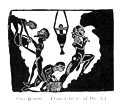 |
|
Clay Quarry. (From a tablet at Berlin.)
|
lence of the workmanship lies in the material, which is very fine, and prepared with
the utmost care; also in the execution and in the baking. Its thinness as well as the hardness
of its sides, even in vessels of large dimensions, astonishes experts in such matters. The
shapes are mostly produced by the potter's wheel, but also by hand in the case of vessels too
large to be conveniently placed on the wheel; for example, the largest wine-jars. The
prehistoric pottery from Mycenae, the Troad, and other Hellenic sites, was also made by hand.
Whereas small vessels were made of a single piece, in the case of large ones, the body,
handles,
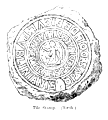 |
|
Tile Stamp. (Birch.)
|
feet, and neck were fashioned separately, and then united. They were first dried in
the sun, then twice baked, before and after the painting. The colours are no less admirable
than the workmanship. The clay shows a beautiful bright reddish yellow, which is produced by
the addition of colouring matter, and is also further intensified by a thin coating of glaze.
The black colour, which often verges upon green and is of a brilliant lustre, is then applied.
Either
1.
the design stands out black against the bright background, or
2.
the figures appear in red on a black ground, the former being the earlier method. Other
colours, especially white or dark-red, were applied after the black glaze had been burned
into the clay by the second baking, and served as a
 |
|
Archaic Vase with Owl Head and Characteristics of a Woman. (Schliemann,
Troja. )
|
less lasting adornment. In later times yellow, green, blue, brown, and gold were
also used.
In the case of vases with black figures, the vase was first turned on the wheel, and, in
order to give it a surface of deeper red, clay finely ground and mixed with water to the
consistency of cream, technically known as “slip,” was applied by a brush
or otherwise while it was still revolving. The outline of the design was next roughly
sketched, either with a point or in light-red ochre with a brush. The vase was then dried in
the sun, and again put on the wheel, and the glaze, finely powdered and mixed with water, was
applied to it with a brush as it revolved. The vase was then, in some cases, fired for the
first time in the kiln in order to provide a smooth, almost non-absorbent surface for the use
of the painter. The painter then put on the black-enamel figures and ornaments with a brush.
After the firing of the enamel, the details
 |
|
Archaic Greek Vases. (Birch.)
|
were drawn in by incised lines, cutting through the enamel down to the clay body of the
vase.
In vases with red figures, instead of the figures being painted in black, the ground was
covered with black enamel and the figures left, showing the glazed red
“slip” which covers the whole vase. This method produced a great artistic
advance in the beauty of the figures, the details and inner lines of which could be executed
with freedom and ease by brush-marked lines, instead of by the laborious process of cutting
incised lines through the very hard black enamel.
Lastly, the form deserves great praise. The vases of the best period present the most
tasteful elegance of form, that is at once fine and strong, and the most delicate proportion
of the various parts to each other and to the whole, without interfering with their practical
utility. It was not until the times when taste had begun to degenerate that the fashion was
introduced of giving to
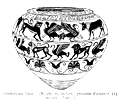 |
|
Corinthian Vase. (Height, 8 1/2 inches; greatest diameter, 11 1/2 inches.
Vulci.)
|
clay ware, by means of moulds, all kinds of grotesque forms of men and beasts, and
of furnishing them with plastic, as well as painted, ornamentation.
The technique of ancient pottery is illustrated by the following figures. The first
represents a potter seated in front of an oven, from which he takes with a stick a small vase
which has been newly glazed, while two other vessels are standing to dry on an oven, the door
of which is closed. The remaining figures, from a tablet at Berlin, explain themselves.
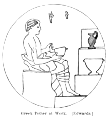 |
|
Greek Potter at Work. (Edwards.)
|
Among the votive tablets in the Louvre there are two from Corinth. The first of these
represents an early Greek type of kiln, which is domed over, and has a space for the fuel on
one side and a door in the side of the upper chamber, through which the pottery could be put
in and withdrawn. The second shows a potter applying painted bands while the vessel revolves
on the wheel.
The ovens (
κάμινοι,
fornaces) for
baking vases seem to have differed very little from those of the present day. The remains of
such ovens, dating from a late Roman period, have been found in Germany, France, England, and
Italy. The most perfect, perhaps, was that found in 1881, at the little Roman colonia
situated between the villages of
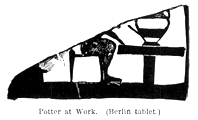 |
|
Potter at Work. (Berlin tablet.)
|
Heddernheim and Praunheim near Frankfort; it has now been destroyed by the owner of
the property on which it was found, but an excellent set of plans were drawn up before its
destruction, by Donner, and published in the
Annali dell' Inst. 1882 (Tav. U
3-6).
The following illustrations are from paintings on a number of
πίνακες, or small clay tablets, found at Penteskaphia near Corinth in 1879, and
now in the Museum at Berlin. They date from the sixth century B.C.
In the preceding cut, the potter is seated beside his wheel, which he turns with one hand,
while with the other he applies ornament either with
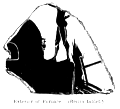 |
|
Exterior of Furnace. (Berlin tablet.)
|
a brush or stick; if the ornament was engraved alone, this would have to be done
while the clay was still moist; if painted, the vase would be first dried in the air.
The Romans, with whom, as early as the time of the second king, Numa, a guild (
collegium) of potters existed, neither had vessels of painted clay amongst
their household goods, nor did they employ it for the ornamentation of their graves. In
earlier times at least, they used only coarse and entirely unornamented ware. They imported
artistically executed vases from their neighbours, the Etruscans. In the last hundred years
of the Republic, as well as in the first hundred years after Christ, the chief place
for the manufacture of the red crockery generally used in households was Arretium (Pliny ,
Pliny H. N. xxxv. 160;
Mart.i. 54, 6Mart., xiv. 98; Dennis,
Etruria, ii. 335). The ware of
 |
|
Interior of Furnace. (Berlin tablet.)
|
this place was distinguished by a coral-red colour, and was generally furnished
with glaze and delicate reliefs; in fact, ornamentation in relief was widely employed in
later Roman pottery. Very much valued was the domestic ware, called
vasa
Samia, which was an imitation of the earlier pottery brought from the island of
Samos. It was formed of fine, red-coloured clay, baked very hard, of thin make, and very
delicate workmanship. It was glazed and generally adorned with reliefs, and served especially
for the table use of respectable people who could not afford silver.
While this fine ware was made by hand, the manufacture of ordinary pottery, as well as of
bricks and pipes, especially under the Empire, formed an important industry among
capitalists.
 |
|
Drinking-bowl and Dish of Clay. (Pompeii.)
|
who, on finding good clay on their estates, built potteries and tile-works, and
either worked them on their own account through slaves, or had them carried on by lessees.
The emperor himself, after the time of Tiberius, and the members of the imperial family,
especially the women, pursued a similar trade, as is shown by the trade-mark which, according
to Roman custom, was borne by clay manufactures.
The production of large statues of clay, apart from the purpose of modelling, belongs
amongst the Greeks to the early times. It continued much longer amongst the Italians,
especially amongst the Etruscans, who furnished the temples at Rome with clay images of the
gods before the victorious campaigns in the East brought marble and bronze productions of
Greek art to Rome. On the other hand, throughout the whole of antiquity, the manufacture of
small clay figures of very various kinds, for the decoration of dwellings and graves, and for
playthings for children, etc., was most extensively practised. They were generally made in
moulds, and after baking were decorated with a coating of colour. The excellence which Greek
art attained in this department, as in others, is shown by the
“figurines” discovered at Tanagra in and after 1874. Very important, too,
was the manufacture of clay reliefs, partly with figured representation
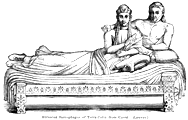 |
|
Etruscan Sarcophagus of Terra- Cotta from Caeré. (Louvre.)
|
and partly with arabesque patterns, for the embellishment of columns, windows,
cornices, and also of tombstones and sarcophagi.
The reader is referred for further details and illustrations to the article
Vas, and to the following works:
Krause,
Angeiologie (1854); Blümner,
Technologie und
Terminologie, etc., vol. ii.; Birch,
History of Ancient Pottery
(2d ed. 1873); Jacquemart,
History of the Ceramic Art (Eng.
trans. 1873);
Kekulé, Thonfiguren aus Tanagra
(1878);
Jännicke, Grundriss der Keramik (1879);
Henzen, Catalogue des Figurines Antiques de Terre Cuite du Musée du
Louvre (1883);
Kekulé, Die Antiken
Terracotten (1880); id.
Die Terracotten von Sicilien
(1884); Dumont and
Chaplain, Céramiques
(1888);
Pottier, Les Statuettes de Terre Cuites dans l'
Antiquité (1890); and
Robert, La
Céramique (1892).


















